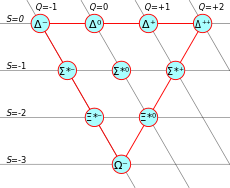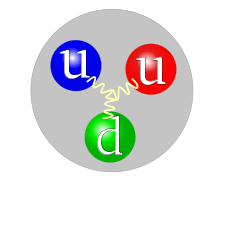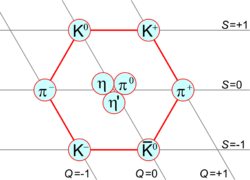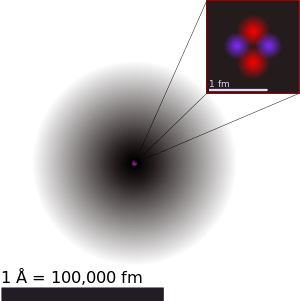List of particles
This is a list of known and hypothesized particles.
Elementary particles
Elementary particles are particles with no measurable internal structure; that is, it is unknown whether they are composed of other particles.[1] They are the fundamental objects of quantum field theory. Many families and sub-families of elementary particles exist. Elementary particles are classified according to their spin. Fermions have half-integer spin while bosons have integer spin. All the particles of the Standard Model have been experimentally observed, recently including the Higgs boson in 2012.[2][3] Many other hypothetical elementary particles, such as the graviton, have been proposed, but not observed experimentally.
Fermions
Fermions are one of the two fundamental classes of particles, the other being bosons. Fermion particles are described by Fermi–Dirac statistics and have quantum numbers described by the Pauli exclusion principle. They include the quarks and leptons, as well as any composite particles consisting of an odd number of these, such as all baryons and many atoms and nuclei.
Fermions have half-integer spin; for all known elementary fermions this is 1⁄2. All known fermions, except neutrinos, are also Dirac fermions; that is, each known fermion has its own distinct antiparticle. It is not known whether the neutrino is a Dirac fermion or a Majorana fermion.[4] Fermions are the basic building blocks of all matter. They are classified according to whether they interact via the strong interaction or not. In the Standard Model, there are 12 types of elementary fermions: six quarks and six leptons.
Quarks
Quarks are the fundamental constituents of hadrons and interact via the strong force. Quarks are the only known carriers of fractional charge, but because they combine in groups of three (baryons) or in pairs of one quark and one antiquark (mesons), only integer charge is observed in nature. Their respective antiparticles are the antiquarks, which are identical except that they carry the opposite electric charge (for example the up quark carries charge +2⁄3, while the up antiquark carries charge −2⁄3), color charge, and baryon number. There are six flavors of quarks; the three positively charged quarks are called "up-type quarks" while the three negatively charged quarks are called "down-type quarks".
| Generation | Name | Symbol | Antiparticle | Spin | Charge (e) | Mass (MeV/c2) [5] |
|---|---|---|---|---|---|---|
| 1 | up | u | u |
1⁄2 | +2⁄3 | 2.2+0.6 −0.4 |
| down | d | d |
1⁄2 | −1⁄3 | 4.6+0.5 −0.4 | |
| 2 | charm | c | c |
1⁄2 | +2⁄3 | 1,280±30 |
| strange | s | s |
1⁄2 | −1⁄3 | 96+8 −4 | |
| 3 | top | t | t |
1⁄2 | +2⁄3 | 173,100±600 |
| bottom | b | b |
1⁄2 | −1⁄3 | 4,180+40 −30 |
Leptons
Leptons do not interact via the strong interaction. Their respective antiparticles are the antileptons, which are identical, except that they carry the opposite electric charge and lepton number. The antiparticle of an electron is an antielectron, which is almost always called a "positron" for historical reasons. There are six leptons in total; the three charged leptons are called "electron-like leptons", while the neutral leptons are called "neutrinos". Neutrinos are known to oscillate, so that neutrinos of definite flavor do not have definite mass, rather they exist in a superposition of mass eigenstates. The hypothetical heavy right-handed neutrino, called a "sterile neutrino", has been left off the list.
| Generation | Name | Symbol | Antiparticle | Spin | Charge (e) | Mass (MeV/c2) [5] |
|---|---|---|---|---|---|---|
| 1 | Electron | e− | e+ |
1⁄2 | −1 | 0.511[note 1] |
| Electron neutrino | ν e | ν e |
1⁄2 | 0 | < 0.0000022 | |
| 2 | Muon | μ− | μ+ |
1⁄2 | −1 | 105.7[note 2] |
| Muon neutrino | ν μ | ν μ |
1⁄2 | 0 | < 0.170 | |
| 3 | Tau | τ− | τ+ |
1⁄2 | −1 | 1,776.86±0.12 |
| Tau neutrino | ν τ | ν τ |
1⁄2 | 0 | < 15.5 | |
- The electron mass is known very precisely as 0.5109989461±0.0000000031 MeV
- The muon mass is known very precisely as 105.6583745±0.0000024 MeV
Bosons
Bosons are one of the two fundamental classes of particles, the other being fermions. Bosons are characterized by Bose–Einstein statistics and all have integer spins. Bosons may be either elementary, like photons and gluons, or composite, like mesons.
According to the Standard Model the elementary bosons are:
| Name | Symbol | Antiparticle | Spin | Charge (e) | Mass (GeV/c2) [5] | Interaction mediated | Observed |
|---|---|---|---|---|---|---|---|
| Photon | γ | Self | 1 | 0 | 0 | Electromagnetism | Yes |
| W boson | W− | W+ | 1 | −1 | 80.385±0.015 | Weak interaction | Yes |
| Z boson | Z | Self | 1 | 0 | 91.1875±0.0021 | Weak interaction | Yes |
| Gluon | g | Self | 1 | 0 | 0 | Strong interaction | Yes |
| Higgs boson | H0 | Self | 0 | 0 | 125.09±0.24 | Mass | Yes |
The Higgs boson is postulated by the electroweak theory primarily to explain the origin of particle masses. In a process known as the "Higgs mechanism", the Higgs boson and the other gauge bosons in the Standard Model acquire mass via spontaneous symmetry breaking of the SU(2) gauge symmetry. The Minimal Supersymmetric Standard Model (MSSM) predicts several Higgs bosons. A new particle expected to be the Higgs boson was observed at the CERN/LHC on 14 March 2013, around the energy of 126.5 GeV with an accuracy of close to five sigma (99.9999%, which is accepted as definitive). The Higgs mechanism giving mass to other particles has not been observed.
Elementary bosons responsible for the four fundamental forces of nature are called force particles (gauge bosons). Strong interaction is mediated by the gluon, weak interaction is mediated by the W and Z bosons.
| Name | Symbol | Antiparticle | Spin | Charge (e) | Mass (GeV/c2) [5] | Interaction mediated | Observed |
|---|---|---|---|---|---|---|---|
| Graviton | G | Self | 2 | 0 | 0 | Gravitation | No |
The graviton, listed separately above, is a hypothetical particle that has been included in some extensions to the standard model to mediate the gravitational force. It is in a peculiar category between known and hypothetical particles: As an unobserved particle that is not predicted by, nor required for the Standard Model, it belongs in the table of hypothetical particles, below. But gravitational force itself is a certainty, and expressing that known force in the framework of a quantum field theory requires a boson to mediate it.
Hypothetical particles
Supersymmetric theories predict the existence of more particles, none of which have been confirmed experimentally.
| Superpartner | Spin | Notes | superpartner of: |
|---|---|---|---|
| chargino | 1⁄2 | The charginos are superpositions of the superpartners of charged Standard Model bosons: charged Higgs boson and W boson. The MSSM predicts two pairs of charginos. | charged bosons |
| gluino | 1⁄2 | Eight gluons and eight gluinos. | gluon |
| gravitino | 3⁄2 | Predicted by supergravity (SUGRA). The graviton is hypothetical, too – see next table. | graviton |
| Higgsino | 1⁄2 | For supersymmetry there is a need for several Higgs bosons, neutral and charged, according with their superpartners. | Higgs boson |
| neutralino | 1⁄2 | The neutralinos are superpositions of the superpartners of neutral Standard Model bosons: neutral Higgs boson, Z boson and photon. The lightest neutralino is a leading candidate for dark matter. The MSSM predicts four neutralinos. | neutral bosons |
| photino | 1⁄2 | Mixing with zino and neutral Higgsinos for neutralinos. | photon |
| sleptons | 0 | The superpartners of the leptons (electron, muon, tau) and the neutrinos. | leptons |
| sneutrino | 0 | Introduced by many extensions of the Standard Supermodel, and may be needed to explain the LSND results. A special role has the sterile sneutrino, the supersymmetric counterpart of the hypothetical right-handed neutrino, called the "sterile neutrino". | neutrino |
| squarks | 0 | The stop squark (superpartner of the top quark) is thought to have a low mass and is often the subject of experimental searches. | quarks |
| wino, zino | 1⁄2 | The charged wino mixing with the charged Higgsino for charginos, for the zino see line above. | W± and Z0 bosons |
Just as the photon, Z boson and W± bosons are superpositions of the B0, W0, W1, and W2 fields, the photino, zino, and wino± are superpositions of the bino0, wino0, wino1, and wino2. No matter if one uses the original gauginos or this superpositions as a basis, the only predicted physical particles are neutralinos and charginos as a superposition of them together with the Higgsinos.
Other theories predict the existence of additional bosons:
| Name | Spin | Notes |
|---|---|---|
| axion | 0 | A pseudoscalar particle introduced in Peccei–Quinn theory to solve the strong-CP problem. |
| axino | 1⁄2 | Superpartner of the axion. Forms, together with the saxion and axion, a supermultiplet in supersymmetric extensions of Peccei–Quinn theory. |
| branon | ? | Predicted in brane world models. |
| chameleon | 0 | a possible candidate for dark energy and dark matter, and may contribute to cosmic inflation. |
| dilaton | 0 | Predicted in some string theories. |
| dilatino | 1⁄2 | Superpartner of the dilaton. |
| dual graviton | 2 | Has been hypothesized as dual of graviton under electric–magnetic duality] in supergravity. |
| graviphoton | 1 | Also known as "gravivector".[6] |
| graviscalar | 0 | Also known as "radion". |
| inflaton | 0 | Unknown force-carrier that is presumed to have the physical cause of cosmological “inflation” – the rapid expansion from 10−35 to 10−34 seconds after the Big Bang. |
| magnetic photon | ? | A. Salam (1966). "Magnetic monopole and two photon theories of C-violation." Physics Letters 22 (5): 683–684. |
| majoron | 0 | Predicted to understand neutrino masses by the seesaw mechanism. |
| majorana fermion | 1⁄2 ; 3⁄2 ?... | gluino, neutralino, or other – is its own antiparticle. |
| saxion | 0 | |
| X17 particle | ? | possible cause of anomalous measurement results near 17 MeV, and possible candidate for dark matter. |
| X and Y bosons | 1 | These leptoquarks are predicted by GUT theories to be heavier equivalents of the W and Z. |
| W' and Z' bosons | 1 |
Mirror particles are predicted by theories that restore parity symmetry.
"Magnetic monopole" is a generic name for particles with non-zero magnetic charge. They are predicted by some GUTs.
"Tachyon" is a generic name for hypothetical particles that travel faster than the speed of light (and so paradoxically experience time in reverse due to inversal of Theory of relativity) and have an imaginary rest mass, they would violate the laws of causality.
Preons were suggested as subparticles of quarks and leptons, but modern collider experiments have all but ruled out their existence.
Kaluza–Klein towers of particles are predicted by some models of extra dimensions. The extra-dimensional momentum is manifested as extra mass in four-dimensional spacetime.
Composite particles
Hadrons
Hadrons are defined as strongly interacting composite particles. Hadrons are either:
- Composite fermions (especially 3 quarks), in which case they are called baryons.
- Composite bosons (especially 2 quarks), in which case they are called mesons.
Quark models, first proposed in 1964 independently by Murray Gell-Mann and George Zweig (who called quarks "aces"), describe the known hadrons as composed of valence quarks and/or antiquarks, tightly bound by the color force, which is mediated by gluons. A "sea" of virtual quark-antiquark pairs is also present in each hadron.
Baryons


Ordinary baryons (composite fermions) contain three valence quarks or three valence antiquarks each.
- Nucleons are the fermionic constituents of normal atomic nuclei:
- Hyperons, such as the Λ, Σ, Ξ, and Ω particles, which contain one or more strange quarks, are short-lived and heavier than nucleons. Although not normally present in atomic nuclei, they can appear in short-lived hypernuclei.
- A number of charmed and bottom baryons have also been observed.
- Pentaquarks consist of four valence quarks and one valence antiquark.
- Other exotic baryons may also exist.
Mesons

Ordinary mesons are made up of a valence quark and a valence antiquark. Because mesons have spin of 0 or 1 and are not themselves elementary particles, they are "composite" bosons. Examples of mesons include the pion, kaon, and the J/ψ. In quantum hadrodynamics, mesons mediate the residual strong force between nucleons.
At one time or another, positive signatures have been reported for all of the following exotic mesons but their existences have yet to be confirmed.
- A tetraquark consists of two valence quarks and two valence antiquarks;
- A glueball is a bound state of gluons with no valence quarks;
- Hybrid mesons consist of one or more valence quark–antiquark pairs and one or more real gluons.
Atomic nuclei

Atomic nuclei consist of protons and neutrons. Each type of nucleus contains a specific number of protons and a specific number of neutrons, and is called a "nuclide" or "isotope". Nuclear reactions can change one nuclide into another. See table of nuclides for a complete list of isotopes.
Atoms
Atoms are the smallest neutral particles into which matter can be divided by chemical reactions. An atom consists of a small, heavy nucleus surrounded by a relatively large, light cloud of electrons. Each type of atom corresponds to a specific chemical element. To date, 118 elements have been discovered or created.
An atomic nucleus consists of 1 or more protons and 0 or more neutrons. Protons and neutrons are, in turn, made of quarks.
Molecules
Molecules are the smallest particles into which a substance can be divided while maintaining the chemical properties of the substance. Each type of molecule corresponds to a specific chemical substance. A molecule is a composite of two or more atoms. See list of compounds for a list of molecules. Atoms are combined in a fixed proportion to form a molecule. Molecule is one of the most basic units of matter.
Quasiparticles
Quasiparticles are effective particles that exist in many particle systems. The field equations of condensed matter physics are remarkably similar to those of high energy particle physics. As a result, much of the theory of particle physics applies to condensed matter physics as well; in particular, there are a selection of field excitations, called quasi-particles, that can be created and explored. These include:
- Phonons are vibrational modes in a crystal lattice.
- Excitons are bound states of an electron and a hole.
- Plasmons are coherent excitations of a plasma.
- Polaritons are mixtures of photons with other quasi-particles.
- Polarons are moving, charged (quasi-) particles that are surrounded by ions in a material.
- Magnons are coherent excitations of electron spins in a material.
Other
- Accelerons are hypothetical particles postulated to relate neutrino mass to dark energy, and are named for the role they play in the accelerating expansion of the universe
- An anyon is a generalization of fermion and boson in two-dimensional systems like sheets of graphene that obeys braid statistics.
- A plekton is a theoretical kind of particle discussed as a generalization of the braid statistics of the anyon to dimension > 2.
- A WIMP (weakly interacting massive particle) is any one of a number of particles that might explain dark matter (such as the neutralino or the axion).
- A GIMP (gravitationally interacting massive particle) is a particle which provides an alternative explanation of dark matter, instead of the aforementioned WIMP.
- The pomeron, used to explain the elastic scattering of hadrons and the location of Regge poles in Regge theory.
- The skyrmion, a topological solution of the pion field, used to model the low-energy properties of the nucleon, such as the axial vector current coupling and the mass.
- A genon is a particle existing in a closed timelike world line where spacetime is curled as in a Frank Tipler or Ronald Mallett time machine.
- A Goldstone boson is a massless excitation of a field that has been spontaneously broken. The pions are quasi-goldstone bosons (quasi- because they are not exactly massless) of the broken chiral isospin symmetry of quantum chromodynamics.
- A goldstino is a goldstone fermion produced by the spontaneous breaking of supersymmetry.
- An instanton is a field configuration which is a local minimum of the Euclidean action. Instantons are used in nonperturbative calculations of tunneling rates.
- A dyon is a hypothetical particle with both electric and magnetic charges.
- A geon is an electromagnetic or gravitational wave which is held together in a confined region by the gravitational attraction of its own field of energy.
- An inflaton is the generic name for an unidentified scalar particle responsible for the cosmic inflation.
- A spurion is the name given to a "particle" inserted mathematically into an isospin-violating decay in order to analyze it as though it conserved isospin.
- What is called "true muonium", a bound state of a muon and an antimuon, is a theoretical exotic atom which has never been observed.
- A dislon is a localized collective excitation of a crystal dislocation around the static displacement.
Classification by speed
- A tardyon or bradyon travels slower than light and has a non-zero, real rest mass.
- A luxon travels at the speed of light and has no rest mass.
- A tachyon (mentioned above) is a hypothetical particle that travels faster than the speed of light and has an imaginary rest mass.
See also
- List of baryons
- List of compounds for a list of molecules
- List of fictional elements, materials, isotopes and atomic particles
- List of mesons
- Particle zoo
- Ion
- Periodic table for an overview of atoms
- Standard Model for the current consensus theory of these particles
- Table of nuclides
- Timeline of particle discoveries
References
- Sylvie Braibant; Giorgio Giacomelli; Maurizio Spurio (2012). Particles and Fundamental Interactions: An Introduction to Particle Physics (1st ed.). Springer. p. 1. ISBN 978-94-007-2463-1.
- Khachatryan, V.; et al. (CMS Collaboration) (2012). "Observation of a new boson at a mass of 125 GeV with the CMS experiment at the LHC". Physics Letters B. 716 (2012): 30–61. arXiv:1207.7235. Bibcode:2012PhLB..716...30C. doi:10.1016/j.physletb.2012.08.021.
- Abajyan, T.; et al. (ATLAS Collaboration) (2012). "Observation of a new particle in the search for the Standard Model Higgs boson with the ATLAS detector at the LHC". Physics Letters B. 716 (2012): 1–29. arXiv:1207.7214. Bibcode:2012PhLB..716....1A. doi:10.1016/j.physletb.2012.08.020.
- Kayser, Boris (2010). "Two Questions About Neutrinos". arXiv:1012.4469 [hep-ph].
- Particle Data Group (2016). "Review of Particle Physics". Chinese Physics C. 40 (10): 100001. Bibcode:2016ChPhC..40j0001P. doi:10.1088/1674-1137/40/10/100001. hdl:1983/c6dc3926-daee-4d0e-9149-5ff3a8120574.
- Maartens, R. (2004). "Brane-World Gravity" (PDF). Living Reviews in Relativity. 7 (1): 7. arXiv:gr-qc/0312059. Bibcode:2004LRR.....7....7M. doi:10.12942/lrr-2004-7. PMC 5255527. PMID 28163642.